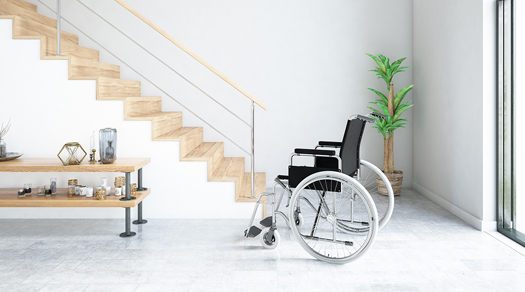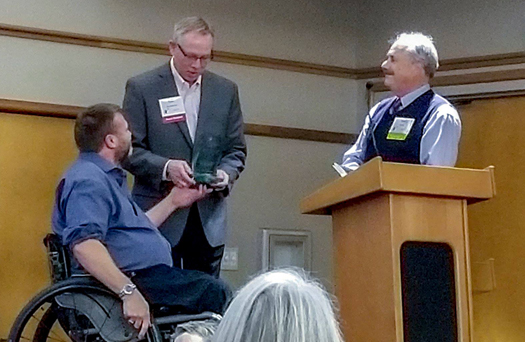Everyone Deserves a Home That Meets Their Needs

Everyone deserves the opportunity to find a home that meets their needs. That seems like a common-sense statement but, to people affected by many types of disabilities, that is simply not always the case in the real estate industry. This became obvious to two local Realtors® who were focused on helping this underserved segment of the population.
As a real estate broker with John L. Scott Real Estate, I become aware of this need as a new agent when a close friend with multiple sclerosis needed a home with basic accessibility features. It became painfully evident that there was no way to search for homes that met those needs on the industry’s listing databases.
In 2004, I founded a company, ABLE Environments, to better serve this segment of the population. It wasn’t until 2017, when I met Barry Long, a motivational speaker and like-minded broker for Sotheby’s Marketplace Real Estate, that things really started gaining traction.
Barry has been paraplegic for over 25 years. He wanted to champion more effective service for real estate clients with disabilities throughout the industry. We decided to combine our efforts and make a difference together. Our first challenge was to improve the way that accessible homes could be marketed and found.
The Multiple Listing Service is a database of homes that are listed for sale that can be searched for specific features, as defined by the listing brokers. For years, there were only two features that a broker could check to identify an accessible home—checkboxes for “Disabled Access” under both Interior Features and Exterior Features. There no definition for that term and listing brokers had no idea of what it meant or why it was important. When a broker used that feature, rarely did it provide information that helped them find an accessible home.
Barry and I knew this all too well and we approached the Northwest Multiple Listing Service (NWMLS) with a request that they change the system. Wonderfully, the NWMLS met our request with enthusiasm and asked us to lead the way.

Barry Long, left, and Tom Minty, at podium, accepted the Northwest Access Fund Best Practices Award on behalf of the Northwest Multiple Listing Service last fall.
We learned that a few other listing systems around the country had attempted to improve accessibility information but none were doing it well. Barry and I wanted to create a system that not only addressed needs locally but one that could be replicated anywhere. Along with the NWMLS, we worked with the National Real Estate Standards Organization (RESO) to create a set of common terms that everyone could understand and use. RESO is the governing body that all multiple listing services around the country use to create their search systems.
It took a while to agree on terminology but once we had definitions, Barry and I developed a model subsection within the MLS input forms that identified 11 features specifically related to accessibility. Now any broker could search these fields to meet the needs of their individual clients and, if any of these 11 features are marked by the listing broker, they can add a document with specific detail about the feature(s) offered.
Definitions of the features and why they are important are now available to every listing broker. It will take time to educate everyone about the importance of this information, not only for clients but to benefit the brokers themselves. To facilitate the understanding and implementation of these new features, we are creating a class with continuing education clock-hours to teach the real estate community how and why.
One of the largest hurdles that Barry and I faced was the impression that many real estate brokers have that accessibility is only an issue for a small subset of our population and it’s not an issue for most people. In fact, many of them have intentionally ignored accessible features in a home because they were afraid it would stigmatize the home as a “handicapped house.” This perspective could not be further from the truth.
According to the last U.S. Census data, around 49 million non-institutionalized people—roughly one in five or 20 percent of the U.S. population—are affected by some type of disability. Among that number, 24 million have “severe” disabilities that impact their Activities of Daily Living (ADLs). This number makes the disability community the single largest minority group in the country. More importantly, it is the only minority group that anyone can become a member of at any time … sometimes in a fraction of a second.
This number is sobering enough if you just consider the needs of an individual living with a disability but their condition rarely impacts only them. If everyone with a disability had two family members, two friends, and two community members (teachers, work colleagues, etc.), the percentage of the population impacted by disability is closer to 90 percent. Now add our aging population, who are living longer, into the equation. Our inability to provide accessible housing is a true crisis.
Our current accessible housing stock is insufficient to meet our needs, and little of the recent construction we see is designed to adapt to significant life changes. As more people look for homes that they can stay in for the rest of their lives, the design and architecture communities are beginning to understand. Universal Design is gaining momentum every year. Housing can be designed without barriers so it is can be used to the greatest extent possible, regardless of age or ability.
The Universal Design approach creates homes that are purposefully built to accommodate a wide spectrum of people and not haphazardly adapted for a few. Consumers with and without disabilities need to ask for more homes that can change along with them. Real estate brokers need to realize that they are not focusing on a subset of the population but are exponentially expanding the potential pool of buyers for a home by making it discoverable by anyone. After all, everyone deserves the opportunity to find a home that meets their needs.
 Contributor Tom Minty serves on the Seattle-King County Advisory Council on Aging & Disability Services and is founding member of the Northwest Universal Design Council, which promotes good design for all ages and abilities all the time.
Contributor Tom Minty serves on the Seattle-King County Advisory Council on Aging & Disability Services and is founding member of the Northwest Universal Design Council, which promotes good design for all ages and abilities all the time.
![AgeWise King County [logo]](https://www.agewisekingcounty.org/wp-content/themes/agewisekingcounty/images/logo.png)